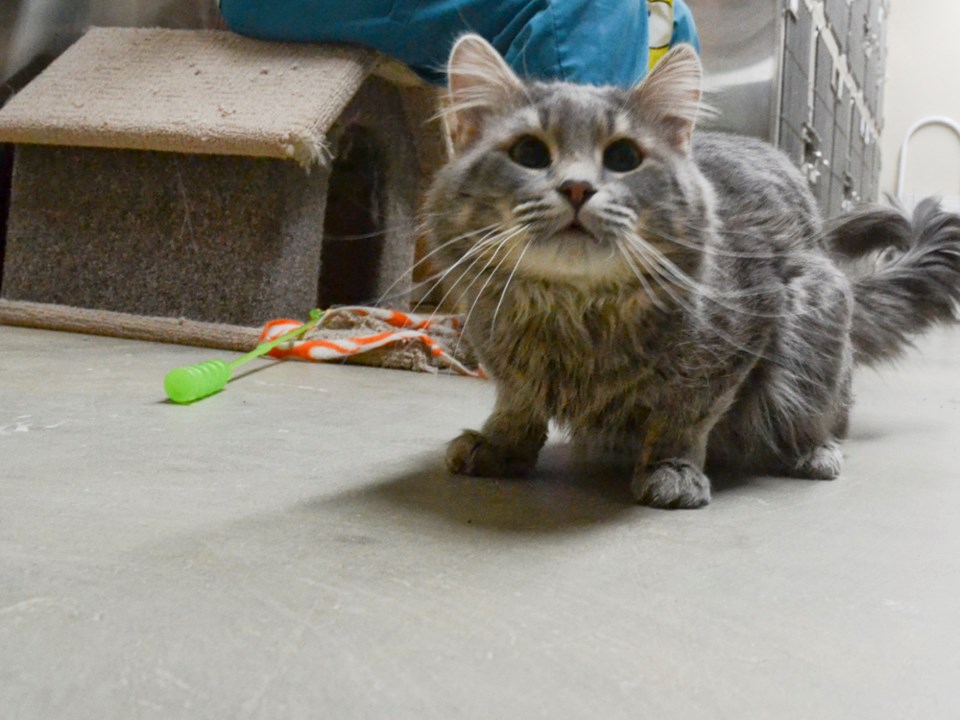A grey, long-haired cat by the name of Logan roams the room during a brief moment of action outside of his cage, occasionally staring down his feline acquaintances in an attempt to intimidate them.
Nearly two years ago, Logan would have done a lot worse.
“He used to be feral and wasn’t good with people,” said Britni Walilko, manager of the Estevan Humane Society. “He wouldn’t let us touch him, and just over a year ago, he couldn’t be near the (cats), but now he’s a totally different cat.”
Persuaded by some food scattered next to Walilko, Logan trots beside the recent Women of Today nominee and gets a pat on the head and soft scratches on the cheek. He doesn’t provide much of a response besides a soft purr.
In the past, however, it wasn’t easy – at times impossible, according to Walilko – to get near Logan.
After many hours of isolation, some affection, and occasional interactions with the public, Logan turned a corner and became a regular housecat.
Now he’s adopted, thanks to someone who met his specific needs, which was a home with an adult family that had no other furry occupants.
On the other side of the building, a five-year-old dog named Joe smiles wildly at the sound of his name. He’s the humane society’s one and only resident of three years.
When visitors drop by to walk a dog, an activity Walilko strongly encourages, staff members often recommend them Joe. He loves walks and is extremely friendly, but like Logan, he requires a home with an adult family that has no other pets.
Through their Facebook page that garners nearly 2,000 likes and the general word- of-mouth that coincides with a smaller city environment, Joe is likely to find a home one day.
“He’d be great for a rig guy,” Walilko said. “Just make sure you treat him respectfully and don’t let him run off the leash. But he’s not hard to handle by any means.”
Dogs at the humane society are the hardest to accommodate, admitted Walilko. She pointed out how Joe’s one-pet-in-the-household requirement combined with the greater responsibilities that come with owning a dog, make for a tough pitch. There are also far fewer dogs than cats, and as a result, cats are more frequently adopted at the humane society.
She noted it’s rare for the humane society to have a shortage of cats, the majority of which are strays found in the Energy City.
“Animal control officers start trapping when it’s nice outside,” Walilko said, adding their facility will soon be chock full of cats.
It’s difficult for an animal lover, like Walilko, to provide the society’s occupants with only a few minutes of daily playtime and belly scratches, but she is confident they’ll find a home.
“I cope because I have three cats at home and when I pet them I think how the other animals will one day end up in a home, too, and how great that will make them feel,” she said.
The staff at the humane society provides no shortage of affection for the animals, but the hormones occasionally consume the room and produce a stressful environment for both cats and dogs, often perpetuated by bouts of extreme barking, scratching and hissing.
Walilko said that even if adoption isn’t currently an option for someone, lots can be done to assist animals at the humane society.
Chester is an old cat who is free to adopt, but up until now, required extensive dental work that can cost up to several hundred dollars. A generous sponsorship has covered Chester’s dental work, and he is now gaining more public interest as a result.
“By sponsoring an animal, you’re putting an animal on a direct path of being adopted,” Walilko said.
She also said people are welcome to drop by the facility to pet the animals as long as they’re not interfering with the staff’s work routine.
The society’s Barn Buddies program, which is designed for people with barns or large shops looking for a mouser, is now underway as well. People adopting a cat through the Barn Buddies program can adopt a cat for a significantly lower fee as long as they have a barn or shop to house them in. If the adopted cat is not already neutered, it must be within 45 days of its adoption. Walilko said all adoption processes require cats to be fixed within 45 days, but some of that cost is refundable.




